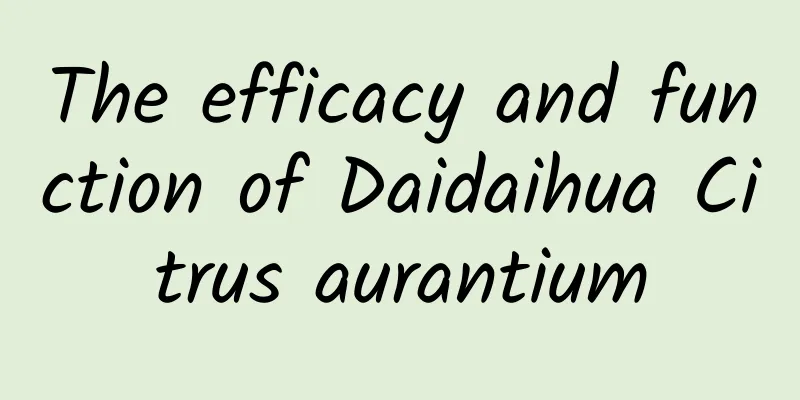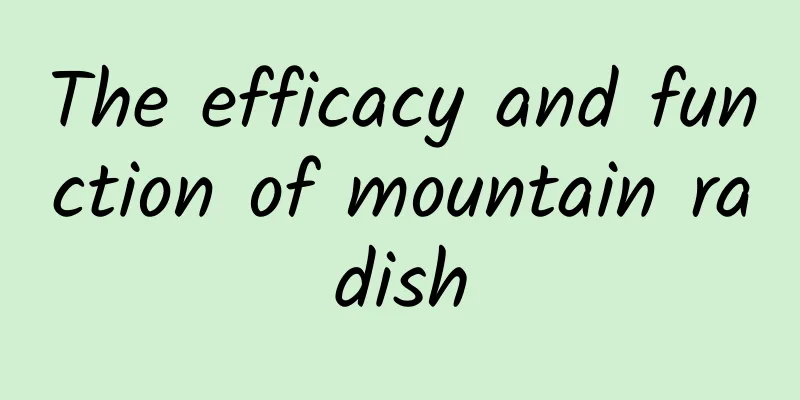The efficacy and function of Daidaihua Citrus aurantium

|
Citrus aurantium is a very nutritious and precious medicinal material. Eating it regularly can have very good effects and functions. So how should we eat Citrus aurantium? What specific benefits can eating Citrus aurantium have for our body? We need to understand some professional knowledge of Citrus aurantium to answer these questions. 【English Name】 Bitter Orange Fruit [Alias] Daidai, Daidaiyuan, Suzhike. [Source] It is the fruit of Citrus aurantium L.var.amara Engl., a plant of the Rutaceae family . Pick the unripe green fruits in July and August, cut them in half from the middle, and dry them in the sun or in an oven. [Original morphology] An evergreen small tree with sparsely covered short thorns on the branches and angular young branches. The leaves are elliptical to ovate-elliptical, 5-10 cm long and 2.5-5 cm wide; the petiole is 2-2.5 cm long, and the leaf wings are inverted cordate. The flowers are in racemes; the calyx is 5-lobed, with lobes oval; the flowers are white, with 5 petals, 2 to 2.5 cm long; there are 21 to 24 stamens, often 3 to 5 of them are combined. The fruit is oblate, 7 to 8 cm in diameter, and has no aroma. The flowering period is from May to June, and the fruit ripens in December. 【Habitat distribution】 Cultivated in low mountain areas or hills. Mainly produced in Jiangsu and Zhejiang. [Properties] After processing, the medicinal material is hemispherical, with a diameter of 3 to 4 cm; the surface is green-yellow or gray-yellow-brown, with reticular wrinkles, and there is a remnant of persistent calyx at the base of the fruit stalk; the outer pericarp is 0.5 to 1 cm thick, slightly turned outward, with 9 to 11 petals, each with 1 to several unripe seeds, and the central axis is 4 to 8 mm wide. Tastes bitter and sour. [Chemical composition] Contains volatile oil, mainly limonene, and also contains decanal, nonanal, dodecanoic acid, linalyl acetate, nerolyl acetate, geranyl acetate; also contains hesperidin, neohesperidin, etc. [Nature and flavor] Slightly cold in nature, bitter and sour in taste. 【Functions and indications】Promotes the flow of qi, relieves fullness, helps digestion, and resolves phlegm. Used for chest and abdominal distension and pain, indigestion, phlegm and rectal prolapse. 【Excerpt】 《*Dictionary》 The above is some introduction to the effects and functions of the traditional Chinese medicine Citrus aurantium. Citrus aurantium is of great help to human diseases, but it is worth noting that we should use symptomatic medication according to our personal physical condition and avoid indiscriminate consumption. |
<<: The efficacy and function of Silengtong
>>: The efficacy and function of Simao
Recommend
The efficacy and function of yellow loquat leaves
After thousands of years of sedimentation and acc...
How much is appropriate to eat at one time?
Poria cocos, also known as polypore, grows in mou...
Crazy snacks, but don't forget to pay attention to this thing in the bag
Have you ever noticed that there is a small desic...
China completes world's first gene-edited pig liver transplant into human body. Are we going to use pig organs soon?
Several encouraging preliminary results have brou...
The efficacy and function of orchid roots
Orchid root is a very common Chinese medicinal ma...
A 90s artist was diagnosed with advanced lung cancer! Why did he get lung cancer when he was young and didn't smoke?
Recently, the topic #Youth 3 contestant Jiang Zhi...
The efficacy and function of fir
Traditional Chinese medicine culture is profound ...
Watermelon rind, great work! This Chinese scientific research team has produced another important result
Recently, Sun Licheng's team from the Future ...
Pink pink pink pink...pink attack, are you ready?
The recently released "Barbie" created ...
Contemporary young people grow up and start wearing long johns
In the past, there was a kind of cold called &quo...
Sabre Holdings: Total revenue for Q4 2014 is expected to be US$639-654 million.
TPG and Silver Lake Partners, major investors in ...
Effects and side effects of Panax notoginseng powder
Panax notoginseng powder is a powder made from Pa...
Why is blood sugar still out of control when eating and exercising together? Here’s the reason…
Diabetes has become widely known for its characte...
The efficacy and function of Cissus pubescens
Cissus pubescens is a very common Chinese medicin...









